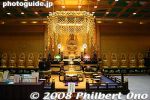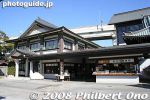Tomioka Hachimangu Shrine & Fukagawa Fudodo Temple 富岡八幡宮・深川不動堂
|
|
|

Facing Eitai-dori road, the main entrance to Tomioka Hachimangu Shrine. The original shrine fronted the ocean, but landfills over the centuries have put the shrine further away from shore.
|
|

Stone marker for Tomioka Hachimangu Shrine.
|
|

Main O-torii gate. The shrine holds various ceremonies and events including an antique flea market. The Fukagawa Hachiman Festival is its most famous festival held annually. The Hon-matsuri full-scale version held every three years (2008, 2011, 2014, etc.
|
|
|
|
|

Tomioka Hachimangu Shrine, Honden worship hall. Koto-ku, Tokyo 富岡八幡宮 本殿
|
|

Tomioka Hachimangu Shrine, Honden worship hall
|
|

Inside Honden worship hall
|
|

Inside Honden worship hall
|
|

The shrine has close historical ties to sumo. Sumo has existed in Japan since at least the 8th century, but modern sumo began to take shape only during the Edo Period from the 17th to 19th centuries.
|
|

During the Edo Period, sumo became more organized and professional. It began with fund-raising sumo tournaments (kanjin-zumo) held at Shinto shrines and Buddhist temples to raise money for the shrine or temple's building construction and repair.
|
|

In 1684, government permission was granted for holding fund-raising sumo tourneys on the grounds of the Tomioka Hachimangu Shrine. Sumo tournaments were then held every year at the shrine.
|
|

Yokozuna Rikishi Monument (Yokozuna Rikishi-hi) at Tomioka Hachimangu Shrine, Koto Ward, Tokyo 横綱力士碑
|
|

Main stone of Yokozuna Rikishi Monument is inscribed with "Yokozuna Rikishi-hi" (横綱力士碑) which means Yokozuna Monument.
|
|

The left stone has a drawing of Yokozuna Shiranui.
|
|

The right stone shows Yokozuna Jimmaku Kyugoro.
|
|

Shiranui verses...
|
|

Jimmaku
|
|

On the right of the centerpiece stone is this newer stone (added in 1983) inscribed with the names of the most recent yokozuna.
|
|

The stone has three rows with seven names each.
|
|

In the top row, we can see from right to left: Asashio, Kashiwado, Taiho, Tochinoumi, Sadanoyama, Tamanoumi, and Kitanofuji. Inscribed are the ring name, hometown, and yokozuna promotion date.
|
|

In the middle row, from right to left: Kotozakura, Wajima, Kitanoumi, Wakanohana (II), Mienoumi, Chiyonofuji, and Takanosato.
|
|

On the bottom row, right to left: Futahaguro, Hokutoumi, Onokuni, Asahifuji, Akebono, Takanohana, and Wakanohana (III).
|
|

Since the front side of this stone is full, it continues on the back as you can see here.
|
|

From right to left: Musashimaru, Asashoryu, and Hakuho. Whenever a new yokozuna is promoted, a name inscription ceremony is held here.
|
|

The centerpiece stone is a 3.5-meter tall, 20-ton monument made in 1900 by the 12th yokozuna Jinmaku Kyugoro after collecting donations from business and political circles.
|
|

Behind the centerpiece stone are 45 yokozuna names (from the first yokozuna up to Wakanohana I) inscribed.
|
|

Names of the first to fifth yokozuna on the centerpiece stone. The first yokozuna was Akashi Shiganosuke. The Edo Period's golden age of sumo was during the time of the 4th yokozuna Tanikaze and 5th yokozuna Onogawa around 1789.
|
|

Names of yokozuna inscribed on the back of the centerpiece stone.
|
|

Names of yokozuna inscribed on the back of the centerpiece stone.
|
|

Names of yokozuna inscribed on the back of the centerpiece stone. On the extreme left is Raiden's name, a special case who was never promoted to Yokozuna, but was certainly Yokozuna material during the Edo Period..
|
|

At the time, only two ten-day tournaments were held annually in front of several thousand people. The sumo ring was located at the site of the present primary school next to the shrine.
|
|

During the years when tournaments were held at the shrine, professional sumo saw many important developments such as the incorporation of the yokozuna dohyo-iri (ring-entering ceremony), the establishment of the banzuke (sumo wrestler ranking sheet),
|
|

and the opening of sumo stables. Fukagawa (the area where the shrine is located) in effect became the birthplace of modern sumo.
|
|

The third stone awaits (still blank).
|
|

In 1791, the fund-raising sumo tournaments were moved to Eko-in temple in Ryogoku. In 1833, official sumo tournaments started at Eko-in temple. In 1909, the first and original Kokugikan sumo arena was subsequently built next to the temple.
|
|

The Yokozuna Rikishi Memorial Monument is also flanked by this smaller monument on the left. This is for sumo rikishi who acheived more than 50 consecutive wins.
|
|

This Rikishi Monument for Over 50 Consecutive Wins has 10 sides, and only five sides are inscribed with names. Which means only five rikishi have achieved more than 50 consecutive wins. One of them is Chiyonofuji.
|
|

Yokozuna Jimmaku Kyugoro
|
|

Although the shrine no longer hosts sumo tournaments, it has maintained close ties to sumo ever since. As of 2008, Koto Ward has several sumo stables (Taiho, Kitanoumi, Musashigawa, Kasugayama, Oshiogawa, Ajigawa, and Tomozuna).
|
|

Ozeki Rikishi Monument 大関力士碑
|
|

The Ozeki Rikishi Monument includes two stones inscribed with the names of Ozeki (those who never reached Yokozuna).
|
|
|

The most recent name inscribed is Kirishima (as of Feb. 2008).
|
|

Stone for handprints and footprints.
|
|
|

The Ozeki Monument also has a Strong Sekiwake Monument inscribed with the names of outstanding Sekiwake.
|
|

The names of the Strong Sekiwake includes Rikidozan whose name is highlighted in white here. Rikidozan later became a pro wrestler and got famous for his "karate chop." He was Korean, and his hometown is not inscribed here.
|
|

Portable Shrine Warehouse. Two giant mikoshi protable shrines are housed here.
|
|

Mikoshi
|
|
|

The shrine's happi coat has a design for the character "Hachi" (for Hachimangu) consisting of two pigeons. Pigeons are regarded as the messengers of the deity worshipped at Hachimangu shrines in Japan.
|
|

Statue of Ino Chukei (Tadataka) (1745-1818), Japan's first geographical surveyor and cartographer. He helped to produce the first accurate map of Japan. Monument built in Oct. 2001. 伊能忠敬
|
|

Ino lived in Fukagawa and before he went off to survey Japan, he always first came to this shrine and prayed. He had studied astronomy, geography, and mathematics.
|
|

He drew a very accurate coastline map of Japan and first used his own money to finance the project. Later, the government recognized the importance and accuracy of Ino's work and increased its support. He did all this while well past age 50.
|
|

Torii gate on the west side
|
|
|
|

Chikara-mochi Strongman's Monument
|
|

Torii gate on the east side
|
|

Kiba Kakunori Monument for square log rolling 角乗り碑
|
|

Kiba Kakunori Monument for square log rolling 角乗り碑
|
|

Gate to Fukagawa Fudodo Temple, the Tokyo branch of Narita-san temple in Narita, Chiba. Belongs to the Shingon Buddhist Sect. 深川不動堂
|
|

Short path to Fukagawa Fudodo Temple. This is almost next to Tomioka Hachimangu Shrine near Monzen-Nakacho Station (Tozai line).
|
|

Straight ahead is the former Hondo main hall. The current Hondo is on the left.
|
|

Fukagawa Fudodo Temple worships Fudō Myōō (不動明王), destroyer of evil. Ahead is the former Hondo main hall. The modern building behind it is the Inner Buddha Hall housing multiple Buddha statues. 内仏殿
|
|

Barrels of sake.
|
|
|
|

Giant waraji straw sandal.
|
|
|

Incense burner and former Hondo hall.
|
|
|

This was the temple's Hondo main hall until April 2011 when it was replaced with a new building built on the left. This building was transplanted here from a temple in Inbanuma, Chiba in 1951 since the previous Hondo was destroyed during World War II
|
|

Sing in front of the former Hondo main hall. 旧本堂
|
|
|

4th floor of Inner Buddha Hall. The ceiling also has a large painting of Dainichi Nyorai (大日如来蓮池図). 内仏殿4階
|
|

How Fukagawa Fudodo Temple was founded.
|
|

Ema prayer tablets.
|
|

Fukagawa Fudoson prayer tablet.
|
|
|
|
|

This building was replaced with the current Hondo main hall.
|
|

Ema prayer tablets for sale.
|
|

Straw sandal lucky charms to bring good health.
|
|
|
|
|
|
|
|
|
|
|

Eitaibashi Bridge spans over the Sumida Bridge. Lit up in blue at night.
|
|

Eitaibashi Bridge spans over the Sumida Bridge. Lit up in blue at night.
|
|
|

Eitaibashi Bridge spans over the Sumida Bridge. Lit up in blue at night.
|
|
|

Tsukudajima skyline across the mouth of Sumida River. Yataibune.
|
|
|
|
|
|
|
|
|
|
|
|